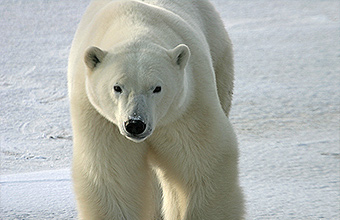
Polar bear (Nanuq)
The largest bear in the world and the Arctic’s top wildlife predator, polar bears are a powerful symbol of the strength and endurance of the Arctic. About 60% of the world’s polar bears live in Canadian territory.
Among the sub-populations living in the western Canadian Arctic, the North Beaufort sub-population remains stable, while the South Beaufort sub-population is declining in numbers. The Chukchi sub-population is data deficient, without enough information to properly understand how this group is faring.
###Importance As an apex predator at the top of the food web, polar bears can signal problems in the Arctic marine ecosystem. Polar bears are highly respected within Inuit culture, traditions and lore, and are valued as an important source of food, skins, and livelihood for skilled Inuit hunters.
###Potential impact of an oil spill Polar bears may ingest oil when grooming their contaminated fur, which causes internal organs to malfunction, sometimes fatally. In acute incidents, a heavily oiled polar bear would lose buoyancy and insulation functions, making them unable to swim safely and vulnerable to the Arctic climate.
New mothers weakened by a winter fast may be particularly vulnerable to shoreline contamination, as they would be forced to walk through the oil to reach the sea ice that is their primary hunting ground.
Sources